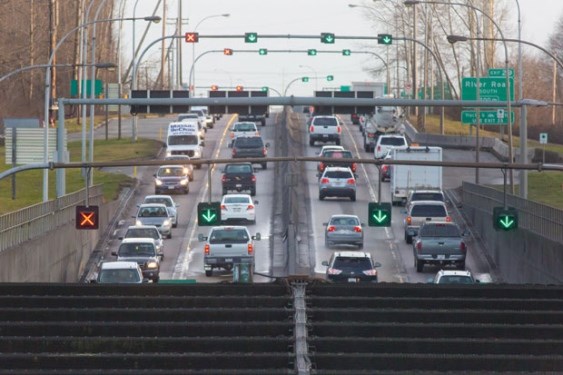In our gridlocked part of the world, there’s not a lot that’s more precious, at least for a beleaguered commuter, than a strip of asphalt that crosses water.
Highways and arterial roads are nice, but they can only take you so far before the inevitable requirement to traverse a river, bay or inlet — those topographical elements that help give the region its charm but wreak havoc on the daily commute.
Given the scarcity and value of these water crossings, it makes sense to utilize them to the absolute maximum, a situation lacking at the Alex Fraser, the six-lane span that has evolved into the second busiest bridge in Greater Vancouver and where significant rush hour back-ups have become the norm.
In an overdue move, the province announced recently it will explore the idea of implementing a counterflow system at the bridge, which should bring some initial relief, although history has shown that as soon as additional capacity is provided, it’s quickly swallowed up by drivers seeking the path of least resistance.
The fact Victoria is looking at reconfiguring traffic flow on the Alex Fraser demonstrates the value of even a single lane across water, which leaves me scratching my head with the decision to replace the George Massey Tunnel with a 10-lane bridge.
I’m not opposed to a new bridge, but I do question the plan to mothball the tunnel because doing so offsets commuting gains that will be gained as a result of the estimated $3.5-billion crossing.
I know, I know, there are costly seismic issues in the tube’s future, to say nothing of the shipping industry’s desire to see it removed, but when lanes crossing the river are at such a premium, it seems foolish to forsake ones we already have.
The tunnel is at least 20 years younger than the Pattullo, Lions Gate and Burrard bridges, and slightly newer than the Granville Street and Oak Street bridges, so it’s hard to buy the notion it’s nearing the end of its lifespan.
It’s outdated, for sure, but with a new bridge built slightly upriver to link both Highway 99 and the South Fraser Perimeter Road with Knight Street, a retrofitted tunnel could still play a role well into the future.
It’s a shame its days are numbered because there’s absolutely no doubt water-crossing lanes are precious.
Ted Murphy is the editor of the Delta Optimist, based in Ladner.



